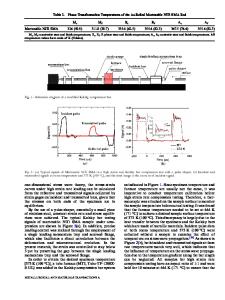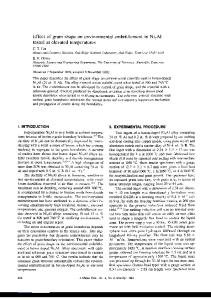Transformation squence in a Cu-Al-Ni shape memory alloy at elevated temperatures
- PDF / 3,409,668 Bytes
- 8 Pages / 594 x 774 pts Page_size
- 23 Downloads / 346 Views
I.
INTRODUCTION
THEshape memory effect occurs in martensitic alloys but, in some alloys, deleterious aging effects in both the martensite and parent phases occur. The Cu-base shape memory alloys have brought many practical applications although they are susceptible to undesirable aging effects.~'2 In order to overcome difficulties resulting from aging effects and to achieve long lifetime capacity of the Cu-based shape memory alloys, it is necessary to know the changes which occur in these alloys during aging. Aging effects in Cu-A1-Ni shape memory alloys have been investigated to some extent. 3-6 There is controversy about the initial structure of the as-quenched alloy. The occurrence of a 2H type metastable phase in the as-quenched /31 Cu-14.2 pet A1-4.3 pct Ni (wt pet) alloy has been reported by Otsuka et al. ,4 while a D0~ structure was reported by others. 2'35 Aging in this alloy was studied up to 400 ~ In the present work, a Cu-14 pet AI-4 pct Ni (wt pet) alloy was investigated systematically, and aging effects in the electron microscope were observed up to 600 ~ The observed microstructural changes were supported by microchemical STEM analysis, and a transformation sequence is proposed.
II.
Heat treatments and in situ observations were carried out using hot stages of Hitachi H500 and Philips 420 microscopes, operated at 125 or 120 kV. Specimens were aged up to 600 ~ for as long as 1 hour followed by cooling to 300 ~ for 10 minutes and reheating back to 600 ~ The heating stage could be tilted to -+60 deg about a single axis. Some samples were examined in the microscope at room temperature with a 60-deg tilt, 360 deg rotation goniometer. III.
RESULTS AND DISCUSSION
A. As-Quenched Alloy The as-quenched alloy showed a large volume fraction of ordered matrix phase plus isolated martensite plates. The martensite phase of the binary Cu-A1 and the ternary Cu-A1Ni systems is well documented. 3'6'7 The M, temperature of the binary alloys gradually decreases with the addition of Ni. ~ The present investigation has focused on precipitation sequences in the nonmartensitic region (i.e., matrix region) during heat treatments. The as-quenched alloy (nonmartensitic region) shows APB contrast as presented in Figure 1. The corresponding diffraction patterns taken at room temperature are given in Figures 2(a) through (c). These patterns are generally com-
EXPERIMENTAL PROCEDURE
A single crystal of composition Cu-14 pet A1-4 pet Ni (wt pct) alloy was prepared using the Bridgman technique, and slices were cut with [001] surface orientation. After mechanical and chemical polishing to a thickness of b.3 mm, 3 mm discs were punched out. The samples were then homogenized at 850 ~ for 48 hours in evacuated quartz capsules and rapidly quenched into iced water (by breaking the capsule after contact with water) in order to avoid precipitation of high temperature phases. Asquenched discs were electropolished at room temperature using a conventional jet polishing technique with an electrolyte consisting of phosphoric acid and water.
Data Loading...











